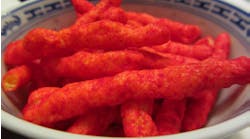The future of synthetic food colors may not be so bright, as more companies are moving to natural colors to appease consumers. Many artificial colorants have already been banned, starting the 1950s, when kids were getting sick on Halloween candy that was colored with Orange No. 2. Early in 1976, Red Dye No. 2 was banned by the FDA. Although a common color at the time, the dye was dropped, causing quite a stir when food companies pulled products from store shelves to reformulate them.
Several studies disagreed about a possible link between Red Dye No. 2 and cancer back then, but Mars discontinued making red M&Ms for years despite never having used Red Dye No. 2 in the candies. Red M&Ms resurfaced within a decade, without Red Dye No. 2, of course, which is still banned today.
Despite many moves to natural colors and even more interest in them, the FDA continues to consider synthetic colors safe – with the two exceptions above.
No easy transition
Currently, only seven synthetic colors are allowed to be used in foods. This may change going forward, but so far, going au naturel hasn't been as easy as it sounds.
Consumers prefer the color of food to match its flavor, yet in the natural world, that's not always easy. Synthetics are more vibrant. Companies like General Mills admit to having a hard time finding natural alternatives that work well enough to switch.
Part of General Mills' pledge to remove artificial flavors and colors from its products by 2017 includes reformulating some of its ready-to-eat cereals. In January, the company relaunched seven cereals, including Frosted, Chocolate and Fruity Cheerios, Trix, Cocoa Puffs, Reese's Puffs and Golden Grahams. The updates are colored with fruit and vegetables juices, spice extracts such as turmeric and annatto.
But General Mills couldn't find suitable alternatives for the blue and green pieces in Trix, so the new cereal version doesn't include those colors. And the red pieces will look different, having been colored with colors from radishes and strawberries.
"We're seeing a steady shift over time from synthetic colors to those from natural sources," observes David Rigg, director of global food marketing, at Sensient Colors LLC, St. Louis. However, "While there were a lot of high-profile announcements in 2015 about natural colors, we really haven’t seen a sudden shift.
[pullquote]
"A lot of consumer packaged goods companies have begun to use color from natural sources in new product introductions, while leaving legacy formulations as-is," he continues. "The transition to color from natural sources is inevitable in the long run, but something that happens over many years. As always, the consumer has the final say on it."
Synthetic hues may be around at least for a while for certain food segments, agrees Ed McIntosh, marketing manager at Flavorchem Corp., Downers Grove, Ill. "There's always going to be a need for synthetic colors due to cost or functionality. Some natural colors cannot provide the exact color specifications and/or requirements needed in some applications," he says. "Consumers are used to the visual cues their favorite foods and beverages provide, so it will take time for them to adjust if a natural color is used for a staple."
"Synthetic colors will still be around for quite a long time, mainly because of cost, versatility and consumer preference," agrees Joe Cavar, R&D manager in the film division of Watson Inc., Orange, Conn., which provides assorted food ingredients, including edible glitter and food colors.
"Cost and versatility go hand-in-hand," Cavar says. "Four or five synthetic colors can be combined to create almost any color you want.
They're nice, clean, bright colors, which plays to consumer preference. Synthetic colors also have excellent shelf stability, so they don’t fade over time. For segments like candy, gum, dessert and bakery toppings −things people enjoy as treats − synthetic colors will still find a lot of use, even as larger segments like breakfast cereal and convenience foods move toward the 'natural' trend."
Waves of development
Some think food coloring may one day incorporate algae. Algae has been touted as "the next great super crop," and there could be promise in developing food products from the slimy greenish aquatic plant, according to research from the University of Copenhagen in Denmark.
Researcher Johan Andersen Ranberg is investigating the possibility of using it in food coloring. An algae crop can be grown using salt water, which is abundant all over the world. In conjunction with the Danish Council for Independent Research, Andersen Ranberg is studying ways to introduce genes into algae that could create a form of carotene, which is produced by green plants and algae to regulate the intake of radiation from the sun, which can also turn things orange.
Andersen Ranberg will conduct the unusual research within the next few years at the University of California at Berkeley, according to a report in January's Modern Farmer Magazine, in hopes of finding out if carotene can be produced this way and how feasible and economical it would be to do so on a large basis. The algae food coloring research furthers the cause of eliminating synthetic food colorants.
"Recent technical advances in stability and hue, such as with our Fruit Juice Concentrate Blue, mean that colors from natural sources can be used in more applications," says Lesley Nicholson, marketing manager, at Wild Flavors & Specialty Ingredients, Decatur, Ill., a unit of ADM.
Consumers have proved they'll pay for changes they believe are healthier, she adds. "[Price] will become less a factor as usage increases and sourcing improves. The staying power of organics has proved this." Nicholson says it's unlikely there will be an outright ban on synthetic colors in the near future, but "consumer demand for colors from natural sources will continue to increase the pace of replacement."
Time will tell, Sensient's Rigg sums up. "There's a segment of the population in the U.S. unconcerned by synthetic colors. Because of that, there will continue to be products and brands that use synthetic colors," he says.
Will the FDA drop the number of acceptable synthetic colors again, or revise the regulations on them as time goes on? "That's always possible," Rigg says. "But the FDA hasn’t signaled that it has any intention of changing its position on the use or safety of synthetic colors. Nothing seems likely in the near term."


